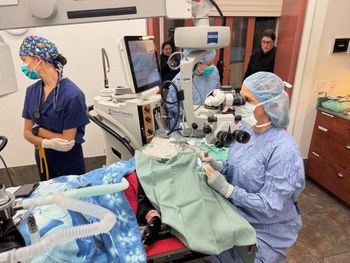
- dvm360 November 2021
- Volume 52
Understanding and diagnosing canine hypothyroidism
Sponsored content by Neogen.
Canine hypothyroidism is a slowly progressive disorder resulting from failure of the thyroid gland to secrete amounts of thyroid hormones adequate for maintaining normal organ functions. Although hypothyroidism is relatively common and thyroid hormone testing is readily available, there is a diagnostic challenge because the clinical signs can be subtle and highly variable. Furthermore, there are numerous causes of low thyroid hormone levels in euthyroid dogs. Because of these factors, making a correct diagnosis of hypothyroidism can be difficult.
Canine hypothyroidism usually results from failure of the thyroid gland. This can be due to lymphocytic thyroiditis (destruction of the thyroid gland by inflammation) or idiopathic thyroid atrophy (degeneration of the thyroid gland in the absence of apparent inflammation). Failure of the thyroid gland is termed primary hypothyroidism and accounts for most cases of canine hypothyroidism. Less commonly, there is secondary hypothyroidism, in which the thyroid gland is healthy but the pituitary gland fails to secrete thyrotropin (TSH), resulting in a secondary failure of the thyroid gland to secrete the hormones thyroxine (T4) and triiodothyronine (T3).
Primary hypothyroidism affects different breeds; mixed breed dogs, golden retrievers, Doberman pinschers, and Labrador retrievers are among those most affected. The age at which clinical signs manifest varies but diagnosis at middle-age to senior years is typical. Because it is the most common, the diagnostic approach to primary hypothyroidism will be the focus of this article.
Clinical signs
Because thyroid hormones affect virtually every organ, the clinical manifestations of disease can be different for each patient. Dogs affected with hypothyroidism often have a decreased metabolic rate resulting in lethargy, dullness, and weight gain without polyphagia. Dermatologic effects are the most common clinical sign of hypothyroidism, including alopecia, a dull and brittle hair coat, skin hyperpigmentation, and pyoderma. Neurologic (peripheral neuropathies, vestibular disease, myopathy) and cardiovascular effects (bradyarrhythmia) are less common but do occur. Rarely, dogs with severe, untreated hypothyroidism can develop myxedema coma, characterized by life-threatening hypothermia, bradyarrhythmia, and deterioration in mental state. Myxedema coma is typically the result of untreated hypothyroidism in the face of additional serious illness.
Clinical pathology
Clinicopathologic changes in hypothyroid dogs are relatively few but characteristic. Hypercholesterolemia is seen in approximately 75% of hypothyroid dogs; some will also have hypertriglyceridemia. Hyperlipidemia can result in the deposition of ocular lipid, which may be recognized on physical examination. A mild, normocytic, normochromic, nonregenerative anemia is seen in approximately one-third of hypothyroid dogs.
Causes of diagnostic confusion: factors that decrease T4 in euthyroid dogs
It is critically important to remember the factors that can influence thyroid hormone testing, and the following should be carefully considered before making a diagnosis of hypothyroidism.
Drugs
Various drugs can influence multiple thyroid hormone tests, especially the total T4 (TT4) test. Prednisone, nonsteroidal antiinflammatory drugs, phenobarbital, and tricyclic antidepressants are some of the more common offenders. If possible, patients should be removed from treatment with these drugs before evaluation for hypothyroidism.
Breed
Euthyroid sighthounds are known to have TT4 levels below the reference interval. Fortunately, these dogs are rarely affected by hypothyroidism.
Age
The TT4 level decreases with age and can dip below the reference interval in very elderly dogs.
Random fluctuations
Occasionally, euthyroid dogs with no other complicating factors can have a TT4 level that transiently drops below the reference interval. This should not be accompanied by clinical signs and repeat evaluation will likely show a TT4 level in the normal range.
Nonthyroidal illness
Systemic illness, malnutrition, trauma, and surgery can all cause decreased thyroid hormone levels. This is often called euthyroid sick syndrome. Although the mechanism is unclear, the condition is thought to be a physiologic adaptation to stress or illness. Most commonly, the TT4 level is decreased, but the free T4 (fT4) level can also be affected.
Diagnostic approach: specific thyroid tests
TT4
The TT4 test includes both bound and unbound (free) T4. T4 is the most abundant hormone secreted by the thyroid gland. This test is used to rule out hypothyroidism. Very few truly hypothyroid dogs will have a normal TT4 level. As mentioned, many factors can cause a low TT4 level in euthyroid dogs. Because of this, a low TT4 level alone should never be used to diagnose hypothyroidism. Additional thyroid diagnostics should be pursued to support the diagnosis before initiating treatment.
fT4
The fT4 is the small fraction of the total T4 that is biologically active. Because the fT4 level is less affected by nonthyroidal illness (NTI) than TT4 levels are, this test is frequently used as a follow-up to a low TT4 result if there is clinical suspicion of hypothyroidism but NTI is present.
TSH
The lack of negative feedback to the pituitary gland in primary hypothyroidism will result in increased TSH. Hypothyroid dogs will have a TSH level above the reference interval in about two-thirds of cases. The TSH test is used in combination with low TT4 and/or fT4 test results to support a diagnosis of hypothyroidism.
Tests for thyroiditis
Some laboratories offer assays for antithyroglobulin, anti-T3, and anti-T4 autoantibodies. Approximately half of dogs with hypothyroidism will have antithyroglobulin antibodies. Anti-T3 and anti-T4 antibodies can also be detected but are less common. These tests can be added to the diagnostic workup of a dog with suspected hypothyroidism to increase confidence in the diagnosis if the combination of TT4 and/or fT4 and TSH levels is equivocal. It is important to note that the absence of these antibodies does not rule out hypothyroidism.
Diagnostic approach: putting it all together
Because of the numerous factors that complicate thyroid diagnostics, a workup for hypothyroidism should always begin with reasonable clinical suspicion based on history, examination findings, and clinicopathologic parameters. It is important to carefully consider and, when possible, exclude nonthyroidal causes of a low T4 level prior to testing.
Definitive diagnosis of hypothyroidism requires multiple supportive thyroid hormone diagnostics, with the most specific combination of tests being TT4, fT4, and TSH. Because few nonthyroidal factors affect TSH levels, a low TT4 and/or fT4 result in combination with a high TSH level is highly consistent with true hypothyroidism.
Because as many as one-third of hypothyroid dogs will have a TSH level within the reference interval, a normal TSH result cannot be used to rule out hypothyroidism. In these cases, a clinical presentation suspicious for hypothyroidism, exclusion of nonthyroidal factors, a low TT4 and fT4 result, and a TSH level in the middle to upper end of the reference interval are sufficient to diagnose hypothyroidism. In cases with equivocal laboratory findings, finding antithyroglobulin, T3, and T4 antibodies may help increase the suspicion for true hypothyroidism.
Laura R. Van Vertloo, DVM, MS, DACVIM, is an assistant professor of veterinary clinical sciences at Iowa State University, College of Veterinary Medicine in Ames, Iowa.
Articles in this issue
about 4 years ago
National Pet Diabetes Month: Raising awareness and making stridesabout 4 years ago
A breakthrough joint supplement for dogs and catsabout 4 years ago
Dental Pain and Inflammation—Acute and Chronicabout 4 years ago
Veterinary technicians embrace their rolesabout 4 years ago
Embark Veterinary releases first-ever purebred dog DNA kitabout 4 years ago
Zoetis adds digital cytology testing to Vetscan Imagystabout 4 years ago
dvm360® welcomes 11 new SAP partners globallyNewsletter
From exam room tips to practice management insights, get trusted veterinary news delivered straight to your inbox—subscribe to dvm360.






